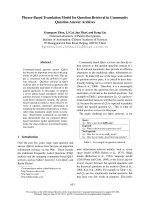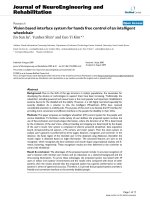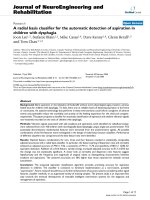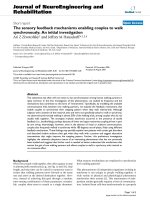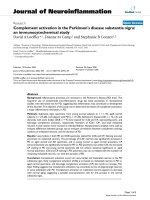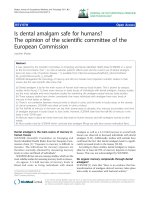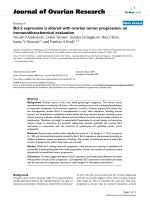báo cáo hóa học: " Vision based interface system for hands free control of an intelligent wheelchair" ppt
Bạn đang xem bản rút gọn của tài liệu. Xem và tải ngay bản đầy đủ của tài liệu tại đây (3.28 MB, 17 trang )
BioMed Central
Page 1 of 17
(page number not for citation purposes)
Journal of NeuroEngineering and
Rehabilitation
Open Access
Research
Vision based interface system for hands free control of an intelligent
wheelchair
Jin Sun Ju
†
, Yunhee Shin
†
and Eun Yi Kim*
†
Address: Visual Information Processing Labratory, Department of Advanced Technology Fusion, Konkuk, University, Seoul, South Korea
Email: Jin Sun Ju - ; Yunhee Shin - ; Eun Yi Kim* -
* Corresponding author †Equal contributors
Abstract
Background: Due to the shift of the age structure in today's populations, the necessities for
developing the devices or technologies to support them have been increasing. Traditionally, the
wheelchair, including powered and manual ones, is the most popular and important rehabilitation/
assistive device for the disabled and the elderly. However, it is still highly restricted especially for
severely disabled. As a solution to this, the Intelligent Wheelchairs (IWs) have received
considerable attention as mobility aids. The purpose of this work is to develop the IW interface for
providing more convenient and efficient interface to the people the disability in their limbs.
Methods: This paper proposes an intelligent wheelchair (IW) control system for the people with
various disabilities. To facilitate a wide variety of user abilities, the proposed system involves the
use of face-inclination and mouth-shape information, where the direction of an IW is determined
by the inclination of the user's face, while proceeding and stopping are determined by the shapes
of the user's mouth. Our system is composed of electric powered wheelchair, data acquisition
board, ultrasonic/infra-red sensors, a PC camera, and vision system. Then the vision system to
analyze user's gestures is performed by three stages: detector, recognizer, and converter. In the
detector, the facial region of the intended user is first obtained using Adaboost, thereafter the
mouth region is detected based on edge information. The extracted features are sent to the
recognizer, which recognizes the face inclination and mouth shape using statistical analysis and K-
means clustering, respectively. These recognition results are then delivered to the converter to
control the wheelchair.
Result & conclusion: The advantages of the proposed system include 1) accurate recognition of
user's intention with minimal user motion and 2) robustness to a cluttered background and the
time-varying illumination. To prove these advantages, the proposed system was tested with 34
users in indoor and outdoor environments and the results were compared with those of other
systems, then the results showed that the proposed system has superior performance to other
systems in terms of speed and accuracy. Therefore, it is proved that proposed system provided a
friendly and convenient interface to the severely disabled people.
Published: 6 August 2009
Journal of NeuroEngineering and Rehabilitation 2009, 6:33 doi:10.1186/1743-0003-6-33
Received: 16 July 2008
Accepted: 6 August 2009
This article is available from: />© 2009 Ju et al; licensee BioMed Central Ltd.
This is an Open Access article distributed under the terms of the Creative Commons Attribution License ( />),
which permits unrestricted use, distribution, and reproduction in any medium, provided the original work is properly cited.
Journal of NeuroEngineering and Rehabilitation 2009, 6:33 />Page 2 of 17
(page number not for citation purposes)
Background
Problem Statement
With the increase of elderly and disabled people, a wide
range support devices and care equipment has been devel-
oped to help improve their quality of life (QOL) [1,2]. In
particular, intelligent wheelchairs (IWs) have received
considerable attention as mobility aids. Essentially, IWs
are electric powered wheelchairs (EPWs) with an embed-
ded computer and sensors, giving them intelligence. Fig-
ure 1 shows the various IWs [3-9].
Two basic techniques have been required to develop IWs:
1) auto navigation techniques for automatic obstacle
detection and avoidance, 2) convenient interfaces that
allow handicapped users to control the IW themselves
using their limited physical abilities. While it is important
to develop a system that enables the user to assist in the
navigation, the system is useless if it cannot be adapted to
the abilities of the user. For example, in the case a user
cannot manipulate a standard joystick, other control
options need to be provided.
Related Research
So far many access methods for IWs have been developed
and then they can be classified as intrusive and non-intru-
sive. They are summarized in Table 1. Intrusive methods
use glasses, a headband, or cap with infrared/ultrasound
emitters to measure the user's intention based on changes
in the ultrasound waves or infrared reflect [10-12]. In con-
trast, non-intrusive methods do not require any addi-
tional devices attached to user's face or head.
As shown in Table 1, voice-based and vision-based meth-
ods belong to the nonintrusive methods. Voice control is
a natural and friendly access method, however, the exist-
ence of other noises in a real environment can lead to
command recognition failure, resulting in safety prob-
lems [13-15]. Accordingly, a lot of research has been
focused on vision-based interfaces, where control is
derived from recognizing the user's gestures by processing
images or videos obtained via a camera. With such inter-
faces, face or head movements are most widely used to
convey the user's intentions. When a user wishes to move
in a certain direction, it is a natural action to look in that
direction, thus movement is initiated based on nodding
the head, while turning is generated by the head direction.
However, such systems have a major drawback, as they are
unable to discriminate between intentional behavior and
unintentional behavior. For example, it is natural for a
user to look at an obstacle as it gets close, however, the
system will turn and go towards that obstacle [16].
Our Proposal
Accordingly, we develop a novel IW interface using face
and mouth recognition for the severely disabled. The
main goal of the present study is to provide a more con-
venient and effective access method for people with vari-
ous disabilities. For accurate recognition of the user's
intention, the direction of the IW is determined according
to the face inclination, while proceeding and stopping are
determined by the shape of the mouth. This format was
inspired based on the operation of car, as the user's face
movements correspond to the steering wheel, while the
user's mouth corresponds to the brake and gas pedal. The
mechanisms prevent an accident in the case the user
instinctively turns their head to look at an obstacle,
thereby making safer. Moreover, the proposed control
mechanisms require minimal user motion, making the
Intel ligent Wheelchairs (IWs)Figure 1
Intelligent Wheelchairs (IWs). (a) GRASP Laboratory Smart Chair [6], (b) Wheelchair of Yutaka et. al [3], (c) Nav Chair
[14].
Journal of NeuroEngineering and Rehabilitation 2009, 6:33 />Page 3 of 17
(page number not for citation purposes)
system more comfortable and more adaptable for the
severely disabled when compared to conventional meth-
ods.
The proposed IW system consists of Facial Feature Detec-
tor (Detector), Facial Feature Recognizer (Recognizer),
and Converter [17]. In our system, the facial region is first
obtained using Adaboost algorithm, which is robust to
the time-varying illumination [18,19]. Thereafter the
mouth regions are detected based on edge information.
These detection results are delivered to the Recognizer,
which recognizes the face inclination and mouth shape.
These recognition results are then delivered to the Con-
verter, thereby the wheelchair are operated. To assess the
effectiveness of the proposed interface, it was tested with
34 users and the results were compared with those of
other systems. Then, the results showed that the proposed
system has the superior performance to others in terms of
accuracy and speed, and they also confirmed that the pro-
posed system can accurately recognize user's gestures in
real-time.
Methods
System Architecture
The proposed IW is composed of electric powered wheel-
chair, data acquisition board, and a PC camera and vision
system. A data acquisition board (DAQ-board) is used to
process the sensor information and control the wheel-
chair. The DAQ-board and a vision system are connected
via a serial port. In our system, a FUJITSU (S6510) note-
book is used as a vision system to process a video stream-
ing received from a PC camera. The camera is connected
to a vision system through a USB port and is mounted on
the front of the wheelchair's tray, pointing down at an
approximately 15 degree angle. The baseline between a
user and camera is 25 cm (9.8 inches).
Table 1: IW controls in literatures
Intelligent Wheelchair Feature Device Supporting Commands
Intrusive interfaces Y.L. Chen, et, al [10] Head orientation tilt sensors, microprocessor Go, back, left, right
SIAMO project [11] Eye gaze Electrode Go, Back, Left, Right
Wheelesley [12] Eye gaze Infrared sensors, ultrasonic
range sensors, electrodes
(EOG)
Go, Stop, Back, Left, Right
Non-intrusive
interfaces
voice Siamo project [11] Voice ultrasonic sensors, infrared
sensors, camera & laser
diode
Go, Back, Left, Right
ROB Chair [13] Voice infrared sensors, ultrasonic
sensors, head microphone
Go, Stop, Speed up, Speed
Down, Rotate
NAVChair [14] Voice Dos-based computer,
ultrasonic transducer, lap
tray, sonar sensors
Go, Stop, Back, Left, Right
TAO project [15] Voice sensors, 2 processor boxes Go, Stop, Back, Left, Right,
Speed Down
vision Yoshida, et, al [22] Face ultrasonic sensors, 2 video
camera
Go, Stop, Left, Right
HGI [16] Head & nose webcam, ultrasonic sensors,
data acquisition board
Go, Left, Right, Speed up,
Speed Down
SIAMO [11] Head CCD color-micro camera Go, Left, Right, Speed up,
Speed Down
Proposed IW Face & Mouth web camera, data acquisition
board
Single commands: Go, Stop,
Left, Right, Rotate
Mixing commands: Go-left,
Go-Right
Journal of NeuroEngineering and Rehabilitation 2009, 6:33 />Page 4 of 17
(page number not for citation purposes)
Our system is described in Figure 2 and specification of
the components is illustrated in Table 2.
Overview of Vision-based Control System
The proposed control system receives and displays a live
video streaming of the user sitting on the wheelchair in
front of the computer. Then, the proposed interface
allows the user to control the wheelchair directly by
changing their face inclination and mouth shape. If the
user wants the wheelchair to move forward, they just say
"Go." Conversely, to stop the wheelchair, the user just
says "Uhm." Here, the control commands using the shape
of the mouth are only effective when the user is looking
forward, thereby preventing over-recognition when the
user is talking to someone. Meanwhile, the direction of
the IW is determined by the inclination (gradient) of the
user's face, instead of the direction of the head. As a result,
the proposed mechanism can discriminate between inten-
tional and unintentional behavior, thereby preventing
potential accidents, when the user instinctively turns their
head to look at an obstacle. Furthermore, the proposed
control mechanisms only require minimal user motion,
making the system safer, more comfortable, and more
adaptable to the severely disabled when compared to con-
ventional methods.
Figure 3 describes the process to recognize user's gestures,
where the recognition is performed by three steps: Detec-
tor, Recognizer, and Converter. First, the facial region is
obtained using the Adaboost algorithm, and the mouth
region is detected based on edge information. These
detection results are then delivered to the Recognizer,
which recognizes the face inclination and mouth shape
using K-means clustering and a statistical analysis, respec-
tively. Thereafter, the recognition results are delivered to
the Converter, which operates the wheelchair. Moreover,
to fully guarantee user safety 10 range sensors are used to
detect obstacles in environment and avoid them. In what
follows, the details for the respective components are
shown.
Facial Feature Detector: Detect User's Face and Mouth
from PC Camera
For each frame of an input streaming, this module local-
izes the facial region and mouth region, and sends them
to the Recognizer. The facial region is obtained using the
Adaboost algorithm for robust face detection, and the
mouth region is obtained using edge information within
the facial region.
For application in a real situation, the face detection
should satisfy the following two requirements: 1) it
should be robust to time-varying illumination and clut-
Table 2: The specification of the proposed IW
Hardware Software
Wheelchair EPW-DAESE M. care Rider OS MS Window XP
DAQ Board Compile Technology SDQ-DA04EX Developed Language MS Visual C++, MS Visual Basic 6.0
Input device Logitech (640 × 480) Up to 30 frame/sec 24-Bit True Color Camera Control Open CV
Vision System Pentium IV 1.7 GHz 1GB Memory
Sensors Two ultrasonic sensors Six Infra-red sensors
The prototype of our IWFigure 2
The prototype of our IW.
Journal of NeuroEngineering and Rehabilitation 2009, 6:33 />Page 5 of 17
(page number not for citation purposes)
The overall architecture of the proposed control systemFigure 3
The overall architecture of the proposed control system.
Journal of NeuroEngineering and Rehabilitation 2009, 6:33 />Page 6 of 17
(page number not for citation purposes)
tered environments and 2) it should be fast enough to
supply real-time processing. Thus, the Adaboost algo-
rithm is used to detect the facial region. This algorithm
was originally proposed by Viola and has been used by
many researchers. The Adaboost learning method is an
iterative procedure for selecting features and combining
classifiers. For each iteration, the features with the mini-
mum misclassification error are selected, and weak classi-
fiers are trained based on the selected features. The
Adaboost learning method keeps combining weak classi-
fiers into a stronger one until it achieves a satisfying per-
formance. To improve the detection speed, a cascade
structure is adopted in each of the face detectors, to
quickly discard the easy-to-classify non-faces. This process
is illustrated in Figure 4.
Figure 5 shows some face detection results. To demon-
strate its robustness, the face detection method was tested
with several standard DBs such as VAK DB [20]. Moreover,
it was tested on the data obtained from real environment.
Figures 5(a) and 5(b) show the results for VAK DBs,
respectively. And Figures 5(c) is the results for online
Outline of face detection using Adaboost algorithmFigure 4
Outline of face detection using Adaboost algorithm.
Journal of NeuroEngineering and Rehabilitation 2009, 6:33 />Page 7 of 17
(page number not for citation purposes)
Face Detection ResultsFigure 5
Face Detection Results. (a) the results for MMI DB, (b) the results for VAK DB, (c) the results for online streaming data.
The mouth detection resultsFigure 6
The mouth detection results. (a) edge detection results, (b) noise removed results.
Journal of NeuroEngineering and Rehabilitation 2009, 6:33 />Page 8 of 17
(page number not for citation purposes)
streaming data. As seen in Figure 5, the proposed method
is robust to the time-varying illumination and the clut-
tered environments.
To reduce the complexity of the mouth detection, it is
detected based on the position of the facial region using
the following properties: 1) the mouth is located in the
lower region of the face and 2) the mouth has a high con-
trast compared to the surroundings. Thus, the mouth
region is localized using an edge detector within a search
region estimated using several heuristic rules based on the
facial region. The details for the search region are given in
our previous work by the current authors [21].
Figure 6 shows mouth detection results. Since the detec-
tion results include both narrow edges and noise, the
noise is eliminated using the post-processing.
Facial Feature Recognizer: Recognize Face Inclination and
Mouth Shape of the Intended User
This module recognizes the user's face inclination and
mouth shape, both of which are continuously and accu-
rately recognized using a statistical analysis and template
matching. As a result, the proposed recognizer enables the
user to control the wheelchair directly by changing their
face inclination and mouth shape. For example, if the user
wants the wheelchair to move forward, the user just says
"Go." Conversely, if the user wants the wheelchair to stop,
the user just says "Uhm." Here, these commands only
have an effect when the user is looking forward, thereby
preventing over-recognition when user is talking to some-
one. Plus the direction of the IW is determined by the
inclination of the user's face instead of the direction of the
user's head.
Let
ρ
denote the orientation of the facial region. Then,
ρ
can be calculated by finding the minimized inertia, which
is defined as follows.
The recognition results for face inclinationFigure 7
The recognition results for face inclination. (a) the commands of turn-left, (b) the commands of turn-right.
Journal of NeuroEngineering and Rehabilitation 2009, 6:33 />Page 9 of 17
(page number not for citation purposes)
where the A is the number of pixels in the region R, and d
is the distance between pixel (r, c) and axis of inertia
which pass through the centroid, ( , ). We obtain these
properties by and .
To minimize the inertia, the derivative is taken with
respect to
β
. Accordingly, the orientation
ρ
can then be
obtained by equation (2).
where
μ
rr
,
μ
cc
and
μ
rc
are the second moments, the respec-
tive of which are defined as
and
. If the value of ρ is less than 0, this
means that the user nods their head slanting to the left.
Otherwise, it means that the user nods their head slanting
to the right. Figure 7 shows the recognition results for the
face inclination.
To recognize the mouth shape in the current frame, tem-
plate matching is performed, where the current mouth
region is compared with mouth-shape templates. These
templates are obtained by K-means clustering from 114
mouth images. K-means clustering is a method of classify-
ing a given data set into a certain number of clusters fixed
a priori. In this experiment, multiple mouth-shape tem-
plates were obtained, which consisted of 6 different
shapes of "Go" and "Uhm." Figure 8 shows the mouth
shape templates.
The results of the comparing the templates with a candi-
date are represented by matching scores. The matching
inertia
A
d
A
A
rr cc
=
=°
=−+−
∑
∑
∈
1
1
1
2
((cos,sin))
(( )cos ( )
(,)
v
rc R
ββ
β
ssin ) ,( ),
(,)
ββ
π
ρ
2
2
=+
∈
∑
rc R
r
c
rr
A
rc R
=
∈
∑
1
(.)
cc
A
rc R
=
∈
∑
1
(.)
ρ
μ
μμ
=
−
rc
rr cc
,
μμ
rr cc
AA
=∑− =∑−
11
22
(), ()rr cc
μ
rc
A
=∑− −
1
()()rrcc
The mouth shape templatesFigure 8
The mouth shape templates. (a) "Uhm" mouth shape templates and, (b) "Go" mouth shape templates.
Journal of NeuroEngineering and Rehabilitation 2009, 6:33 />Page 10 of 17
(page number not for citation purposes)
score between a mouth-shape template and a candidate is
calculated using the Hamming distance, where the Ham-
ming distance between two binary strings is defined as the
number of digits in which they differ.
Here the matching scores for all the mouth-shape tem-
plates and a mouth candidate are calculated, and the
mouth-shape template with the best matching score is
selected.
Converter: Translate User's Gesture into IW's Control
Commands
The proposed system uses a data acquisition board as a
converter to translate the user's gestures into control com-
mands for the IW. Similar to a general electric powered
wheelchair, which is controlled by the voltage passed to
the joystick, a data acquisition board (SDQ-DA04EX) is
used to transform the ADC function and DAC. Figure 9
shows the data acquisition board used in our IW. The
board is connected to a computer through a serial port
and programmed using Visual Basic. The programmed
function then translates the user's gestures into control
commands for the IW.
The commands given from the user interface are passed to
the control program running the wheelchair through the
serial port. The board program then controls the speed
and direction of wheelchair by modifying the voltage
passing through the wheelchair.
Table 3 shows command map between wheelchair move-
ment and output voltage. The proposed system is able to
control both the direction and the velocity of the wheel-
chair, as the user can produce a different output voltage by
changing their mouth shape or face orientation. In addi-
tion to simple commands, such as go-forward, go-back-
Data Acquisition board (SDQ-DA04EX)Figure 9
Data Acquisition board (SDQ-DA04EX).
Journal of NeuroEngineering and Rehabilitation 2009, 6:33 />Page 11 of 17
(page number not for citation purposes)
ward, turn-left, or turn-right, the proposed system can also
give a mixture of two simple commands, similar to joy-
stick control. For example, the wheelchair can go in a 45
degree direction by combining the go-forward and go-
right commands.
Results
Experimental Environments
The interface system of IW was developed in PC platform:
the operation system is Windows XP and CPU is Pentium
1.7 GHz. The Camera is Logitech, which was connected to
the computer using the USB port and supplied 30 color
images sized at 320 × 240 per second.
To assess the validity of the proposed system, it was tested
on 34 participants, including 17 disabled and 17 able
bodied users. The disabled users had the following disa-
bilities: ataxia and quadriplegia from cord-injuries. The
details are summarized in Table 4.
The experiments were performed by two steps. First, the
performance of the proposed system is presented, which
was tested in various environments. The effectiveness of
the proposed system is then discussed in comparison with
other methods.
Experiment I: To measure the accuracy of our interface
For the proposed system to be practical in the real envi-
ronments, it should be robust to various illuminations
and cluttered backgrounds. Thus, the proposed method
was applied to detect and recognize the user's facial fea-
tures in a complex background. Figure 10 shows that the
facial feature detection results. The scenes had a cluttered
stationary background with a varying illumination. As
seen in Figure 10, the results accurately detected the face
and mouth, confirming the robustness to time-varying
illumination, and low sensitivity to a cluttered environ-
ment.
With the proposed system the user's intention is repre-
sented by the inclination of the face and shape of the
mouth, making the accurate recognition of these features
crucial. Figures 11(a) and 11(b) show the recognition
results for the face inclination and the mouth shapes,
respectively. As shown in these figures, they are continu-
ously and accurately recognized.
To quantitatively evaluate the performance of the pro-
posed system, we asked each user to perform contain
commands, such as go straight, stop, turn left or turn right
and repeat the action 50 times.
Table 5 shows the average time taken to detect the face
and facial features, then recognize them in an indoor and
outdoor environment. As a result, the average time taken
to process a frame was about 62 ms, allowing the pro-
posed system to process more than 15 frames/sec on aver-
age (16 frames/sec in indoor and 14 frames/sec in
outdoor). Table 6 shows the recognition rates of the pro-
posed interface for the respective commands. The pro-
posed system shows the precision of 100% and the recall
of 96.5% on average. Thus, this experiments proved that
the proposed system can accurately recognize user's inten-
tions in real-time.
Figure 12 shows some snapshots for the proposed system
to be applied on various environments. Outdoor environ-
ments have a time-varying illumination and more com-
plex background, as shown in Figures 12(b) and 12(d).
However, despite those complexities, the proposed sys-
tem worked very well in both environments. In particular,
in case of someone comes to talk the user (in Figure
12(c)), our system can accurately discriminate between
intentional and unintentional behaviors, thereby prevent-
ing potential accidents, when the user instinctively turns
their head to look at a person.
Table 3: Operation Volts of Intelligent Wheelchair
Commands Output 1 Output2
Go 2.45 V~3.7 2.45 V
Back 1.2 V~2.45 V 2.45 V
Left 2.45 V 1.2 V~3.7 V
Right 2.45 V 2.45 V~3.7 V
Stop 2.45 V 2.45 V
Table 4: Testing Groups
Stage Time (.ms) Number EPW usage Computer usage(*)(%)
Able-bodied users 17 0% 100%(92%)
Disabled users 17 81% 64%(23%)
Journal of NeuroEngineering and Rehabilitation 2009, 6:33 />Page 12 of 17
(page number not for citation purposes)
Experiment II: To compare with other interfaces
To prove the efficiency and effectiveness of the proposed
IW interface, it was also compared with other systems.
Here, two methods were adopted, one is headband-based
method and the other is method using face tracking
[22,23]. Then, the former belongs to the intrusive method
and the latter belongs to the vision-based method. In the
headband-based method, the go-and-stopping is control-
led by nodding user's head to the front or to the rear, and
the direction is changed by nodding user's head to the left
side or to the right side. In such system, the head motions
are measured through a headband that includes an accel-
erometer sensor. On the other hand, a face-based interface
detects user's face in the first frame and tracks it continu-
ously, and then user's face are detected using skin-color
model.
Figure 13 shows the control commands for respective
methods. When visually inspected, our system requires
the smaller motions than others. This tells us our system
is more comfortable and suitable to the severely disabled.
For the practical use by the severely disabled, such systems
should be operable on both indoor and outdoor environ-
ments. Thus, the three systems were evaluated across
indoors and outdoors, changes in time of day and weather
conditions. Such conditions are summarized in Table 7.
And some test maps in indoor and outdoor environments
are shown in Figure 14.
We asked the participants to navigate each map 10 times
using three interfaces. The performances for three inter-
faces were then evaluated in terms of the accuracy and
speed. In those experiments, the face-based method was
Face and mouth detection resultsFigure 10
Face and mouth detection results.
Journal of NeuroEngineering and Rehabilitation 2009, 6:33 />Page 13 of 17
(page number not for citation purposes)
Face and mouth recognition resultsFigure 11
Face and mouth recognition results. (a) face inclination recognitions, (b) mouth shape recognitions.
Journal of NeuroEngineering and Rehabilitation 2009, 6:33 />Page 14 of 17
(page number not for citation purposes)
Table 6: Performance Evaluation Results
Commands Recall Precision
Left turn 0.98 1
Right turn 0.94 1
Go straight 0.96 1
Stop 0.98 1
Table 5: Processing Time (.ms)
Stage Indoor Outdoor
Face Detection 30 32
Mouth detection 15 18
Face inclination recognition 22
Mouth shape recognition 15 16
Total 62 68
IW controls on real environmentsFigure 12
IW controls on real environments.
Journal of NeuroEngineering and Rehabilitation 2009, 6:33 />Page 15 of 17
(page number not for citation purposes)
Intelligent Wheelchair input methodsFigure 13
Intelligent Wheelchair input methods.
Some examples of test mapsFigure 14
Some examples of test maps. (a) Outdoor test map, (b) indoor test map.
Journal of NeuroEngineering and Rehabilitation 2009, 6:33 />Page 16 of 17
(page number not for citation purposes)
tested in only the indoor environments, due to its sensi-
tivity to the time-varying illumination. As mentioned
above, it used the skin-color model to extract user's face,
so it is very sensitive to illumination changes.
Tables 8 and 9 show the summarized performance com-
parisons for the three methods. Table 8 shows the average
times taken to reach the destination for three interfaces.
Among three methods, the face-based method is the slow-
est, whereas there is no significant difference between our
method and the head-band method. Meanwhile, Table 9
shows the recognition accuracies of three methods, where
the proposed-based method produced the best perform-
ance with an average accuracy of 96.5%, while the face-
based method had an accuracy of 87.5% and the head-
band-based method had an accuracy of 88%. In experi-
ments, the face and headband based methods made over-
recognition or miss-recognition in some environments.
When travelling on an uphill (or downhill) place, the
headband method often missed the go-straight and stop
commands. And the face-based method often missed
user's face so that it cannot track user's gestures. Moreover,
it cannot discriminate between intentional and uninten-
tional behaviors, thereby making potential accidents,
when the user instinctively turns their head to look at an
obstacle.
Consequently, these comparisons proved the efficiency
and effectiveness of the proposed system. Moreover, as
shown in Figure 13, the proposed method requires more
minimal user motion than the head-band method, mak-
ing the proposed system more suitable for the severely dis-
abled than conventional methods.
Table 7: Test environments
Places Time and illumination
Indoor (Daytime, fixed illumination)
(Nighttime, fixed illumination)
Outdoor (Daytime, time-varying illumination and a shadow)
(Nighttime, -)
Indoor to outdoor, or vice versa (Daytime, time-varying illumination and shadow)
Table 8: Processing Time
Methods Average time taken to reach the destination (.ms)
Proposed method (test in indoor and outdoor) 48.31 s
Headband-based method (test in indoor and outdoor) 48.61 s
Face-based method (test in indoor) 51.23 s
Table 9: Accuracy (%)
Methods Precision Recall
Proposed method (test in indoor and outdoor) 100 96.5
Headband-based method (test in indoor and outdoor) 89 88
Face-based method (test in indoor) 87 87.5
Publish with Bio Med Central and every
scientist can read your work free of charge
"BioMed Central will be the most significant development for
disseminating the results of biomedical research in our lifetime."
Sir Paul Nurse, Cancer Research UK
Your research papers will be:
available free of charge to the entire biomedical community
peer reviewed and published immediately upon acceptance
cited in PubMed and archived on PubMed Central
yours — you keep the copyright
Submit your manuscript here:
/>BioMedcentral
Journal of NeuroEngineering and Rehabilitation 2009, 6:33 />Page 17 of 17
(page number not for citation purposes)
Discussion & conclusion
In this paper, we developed an IW system, which is
adapted, efficient, and robust for the disabled people with
physical disabilities. In the proposed system, the direction
of IW is determined by user's face inclination, while its
going and stopping is determined by user's mouth shape.
The advantages of the proposed system include the fol-
lowings: 1) minimal user motion, making the proposed
system more adaptable to the severely disabled, than con-
ventional methods. 2) robustness to a cluttered back-
ground and the time-varying illumination and 3) accurate
recognition of user intention based on discriminating
between intentional and unintentional behavior. To
prove these advantages, the proposed system was tested
with 34 users on the indoor outdoor environments.
However, to guarantee full user safety, the proposed sys-
tem also needs to be able to detect and avoid obstacles
automatically thus further research in this area is currently
underway.
Competing interests
Konkuk Univ. will apply for a patent for the proposed IW
interface. The authors are composed of two PhD. Candi-
dates and a professor. The affiliated Konkuk Univ. is the
educational institute, so we are not participating in any
interests.
Authors' contributions
JJ (Ju, Jin Sun), SY (Shin, Yunhee), KE (Kim, Eun Yi) con-
ceived of the research and participated in its design and
coordination. JJ implemented the facial feature detection
and recognition software, conducted the user trials and
drafted the manuscript. SY implemented the hardware for
the IW, and interfaced the vision system with the DAQ
board. KE reconstructed the proposed system to complete
additional user testing and revised the manuscript. All
authors read and approved the final manuscript.
Acknowledgements
We thank Professor Goo, Nam Seo for making thoughtful comments for
our system. This work was supported by the Korea Science and Engineer-
ing Foundation (KOSEF) grant funded by the Korea government (MOST).
(No.R01-2008-000-20167-0)
References
1. Simpson R, LoPresti E, Hayashi S, Nourbakash I, Miller D: The smart
wheelchair component system. Journal of Rehabilitation Research
and Development 2004, 41(3B):429-442.
2. Gomi T, Griffith A: Developing Intelligent Wheelchairs for the
Handicapped. Assistive Technology and Artificial Intelligence 1998,
1458:150-178.
3. Satho Yutaka, sakaue Katsuhiko: Development of Omni-direc-
tional Stereo Vision-based Intelligent Electric Wheelchair.
ICPR 2006:799-804.
4. Park JM, Song J, Cho YJ, Oh SR: Moving among A hybrid control
architecture using a reactive sequencing strategy for mobile
robot navigation. IROS 1999:1279-1284.
5. Murakami Yoshifumi, Kuno Yoshinori, Shimada Nobutaka: Intelli-
gent Wheelchair Moving among people based on their
observations. IEEE Journal :1466-1471.
6. Parikh Sarangi P, Grassi Valdir Jr, Okamoto Jun Jr: Usability study
of a control framework for an Intelligent Wheelchair. Inter-
national Conference on Robotics and Automation Barcelona 2005.
7. Lankenau A, Rofer T: Smart Wheelchairs state of the art in an
Emerging Market. Firs French-Spnish Workshop on Assistive Technol-
ogy 2000:37-39.
8. Mori H, Nakata T, Kamiyama Y: Next-Generation Intelligent
Wheelchair as development by ROTA. 36th Int Symposium on
Robotics (ISR) 2005:39.
9. Miller DP, Slack MG: Design and testing of a low-cost robotic
wheelchair prototype. Autonomous Robotics 1995:77-88.
10. Chen Y-L, Lin J-F: A head orientated wheelchair for people
with disabilities. Disability and Rehabilitation 2003, 25:249-253.
11. Research group of the SIAMO project: The SIAMO project Inte-
gral System for Assisted Mobility. IEEE Robot, Automat, Special
Issue in Res. Autonomous Robotic Wheelchair in Europe 2001.
12. Yanco HA: Shared user computer control of a robotic wheel-
chair system. Dissertation, Department of Electrical Engineering and
computer science, MIT 2000.
13. Pires G, Araujo R, Nunes U, de Almeida AT: ROBCHAIR A semi
autonomous wheelchair for disabled people. 3rd IFAC Sympo-
sium on Intelligent Autonomous Vehicles (IAV'98) 1998:648-652.
14. Levine SP, Bell DA, Jaros LA, Simpson RC, Koren Y: The NavChair
Assistive Wheelchair Navigation System. IEEE Transaction on
rehabilitation engineering 1999.
15. Lu T, Yuan K, Zhu H, Hu H: An Embedded Control system for
Intelligent Wheelchair. IEEE engineering in Medicine & Biology soci-
ety Proceedings of 27th 1999:14-31.
16. Pei JIA, Huosheng Hu: Head gesture recognition for hands-free
control of an Intelligent wheelchair. Industrial robot 2007,
34(1):60-68.
17. Ju JS, Shin Y, Kim EY: Intelligent Wheelchair interface using
face and mouth recognition. International Conference on Consumer
Intelligent User Interface proceeding of 13th 2008:307-314.
18. Viola P, Jones MJ: Molecular Cloning: A Laboratory Manual.
Cold Spring Harbor, Cold Spring Harbor Press; 1989.
19. Viola P, Jones MJ: Robust real-time face detection. International
Journal of Computer Vision 2004:137-154.
20. VAK DB at Konkuk University, in South Korea [http://
viplab.konkuk.ac.kr]
21. Ju JS, Shin Y, Kim EY: Intelligent Wheelchair (IW) Interface
using face and mouth recognition. International Conference on
Intelligent User Interfaces 2009:307-314.
22. Kuno Y, Shimada N, Shirai Y: A robotic wheelchair based on the
integration of human and environmental observations. IEEE
robotic & Automation Magazine 2003:26-34.
23. Hwang S: Development of headband based automated wheel-
chair control system for quadriplegia disabled. MS Thesis,
Konkuk University, Seoul, Korea 2009.
